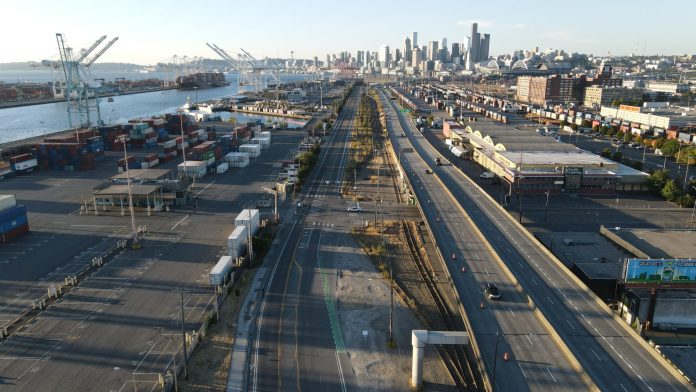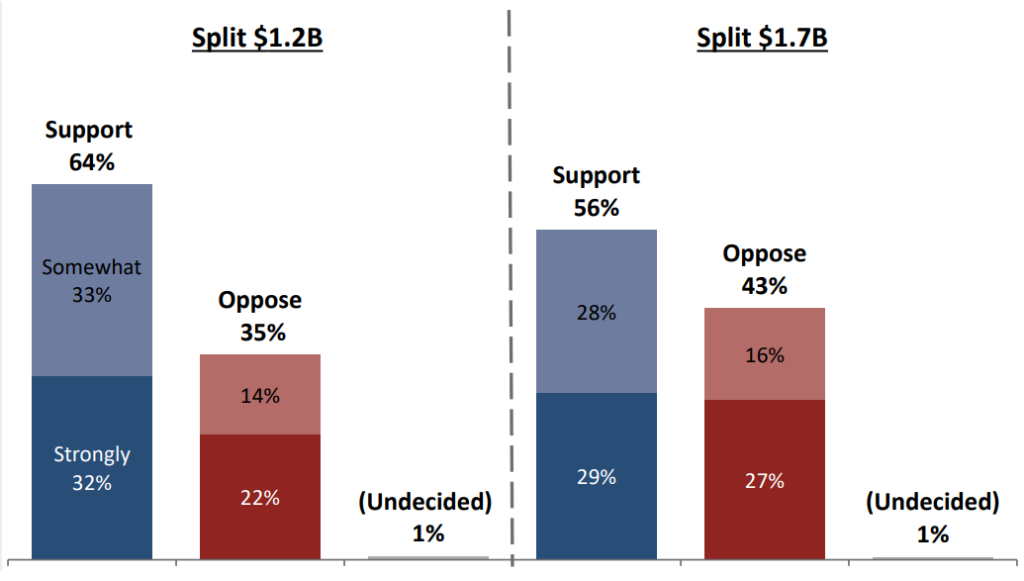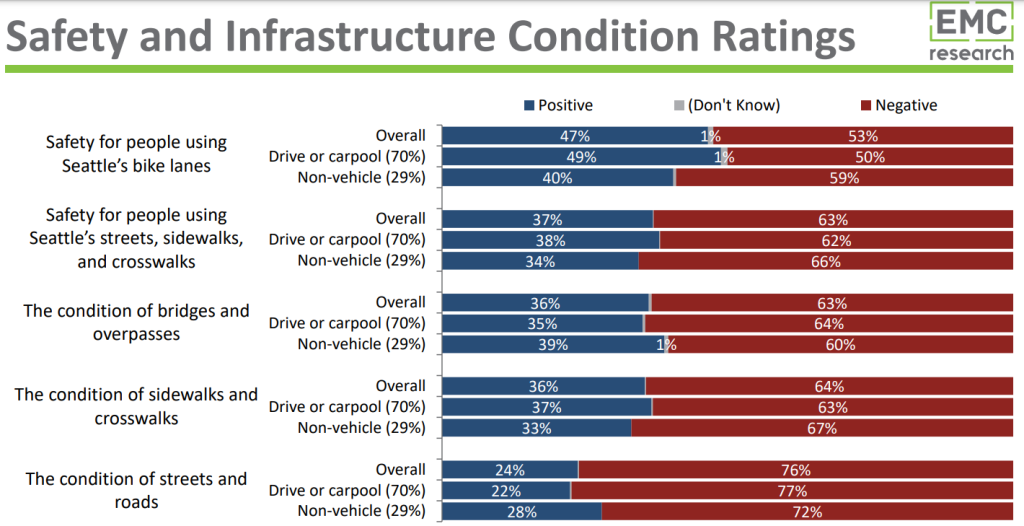
The City tested two levy options: a $1.7 billion package and a smaller $1.2 billion version.
Seattleites want to fund street improvements and they’re not shying away from multi-billion dollar price tags for the next transportation levy, a poll commissioned the Seattle Department of Transportation (SDOT) recently found.
The survey of 1,000 Seattle voters, conducted by EMC Research in December, polled respondents on a hypothetical renewal measure for Move Seattle, a nine-year $930 million levy which funds about 30% of SDOT’s budget and expires at the end of the year. Pollsters asked about a $1.2 billion version, essentially the same amount as Move Seattle adjusted for monetary inflation, and a larger $1.7 billion package that includes more projects. While support did drop in the larger version, it was still comfortably above water, with a margin of 56% support to 43% opposition.
SDOT presented the poll to its levy steering committee on January 9 and also briefed advocates on the findings this week. The Urbanist has published the poll for those curious to see the results in full.
Keeping up with rising costs
Much can change from early polling to final election results, so polls can only provide a rough snapshot. However, it’s worth noting that the Seattle Housing Levy ended up passing by a margin 12 points greater than what polling from last summer found, with 69% of voters approving in November. The 2023 Seattle Housing Levy more than tripled the size of the previous housing levy in order to compensate for rising construction costs in Seattle. This suggests a comfortable cushion for a transportation measure that could double the current levy in size.

Driven by inflation and rising labor and material costs, rapidly increasing construction costs is also plaguing transportation projects across the region, which is a major factor pushing the City to increase the levy’s size as it renews Move Seattle. For example, the Washington State Department of Transportation revealed that a SR 520 lid project in North Capitol Hill is a half billion dollars over budget — a 70% increase. And Sound Transit has revealed a variety of cost overruns, including a Federal Way train base that could be as much as a billion over budget. In effect, construction cost escalation outpaces the inflation rate in general.
In other words, a $1.2 billion levy passed in 2024 would tend to fund fewer projects than a $930 million levy passed in 2015. Seattleites hoping for big ticket items, such as bridge replacements or street overhauls, will likely need to get comfortable with bigger price tags.
Project list still in development
Which projects will make it into the proposal remains largely a mystery; SDOT has only hinted via a project wishlist included with the Seattle Transportation Plan draft, but the scope of projects isn’t defined in that list and the City has intimated that the initial list would need to be culled back.
At a press event celebrating a federal grant for the RapidRide J Line, a project upgrading a portion of the Route 70 bus and overhauling Eastlake Avenue, Mayor Bruce Harrell said the levy proposal was still being formulated and would include a “bottoms up” project list based on input from advocates.
Mayor Bruce Harrell's full response this morning to a question from The Urbanist on his vision for the 2024 transportation levy: pic.twitter.com/oaPd4AdsIr
— The Urbanist (@UrbanistOrg) January 27, 2024
But SDOT’s poll did hint at some of the potential big-ticket items that the City is considering at this point, framing them as only possible in a larger $1.7 billion levy. A new RapidRide line connecting Rainier Beach with Eastlake via Capitol Hill and Beacon Hill was on the list, as well as a second phase of a full rebuild of East Marginal Way S south of S Spokane Street, upgrading pedestrian and bike facilities. Seismic upgrades to the Ballard and Fremont Bridges, originally promised to voters in 2015 but not achieved due to significant cost increases, were also listed as something that would only be possible with a larger levy.
Advocates from transit, bike, pedestrian, disability, and climate organizations have pushed SDOT to be ambitious and strive to realize the City’s lofty goals around climate, safety, and livability. For them, that would entail a major buildout of sidewalks, protected bike lanes, dedicated bus lanes, pedestrian streets, and safer crossings. Those investments found support in the recent poll.
Safety emerged as a top concern for voters with 69% rating safe routes to school for students as important and 66% endorsing reducing “collision-related injuries and fatalities to zero by 2030 through road and pedestrian safety investments on streets with the highest number of crashes.” Two-thirds of people who get around without a car had a negative view of safety while using streets and crosswalks and rated the condition of sidewalks negatively, and the opinion of motorists wasn’t far behind.
Accessibility was clearly a widely-shared concern, with 70% ranking it important to “invest in sidewalks and curb ramps to make Seattle more accessible for pedestrians and people with disabilities.”
Voters also saw the importance of improving connections to transit and shifting away from car dependence, with 67% favorable to a proposal to “create walk, bike, and bus routes between light rail stations and surrounding neighborhoods to enable more people to ride the transit instead of driving.” Plus, 68% rated it important to “make it easier and safer to get around your neighborhood without a car.”
Pedestrian streets and street cafes found interest, too, with 52% backing a “new permanent car-free shopping areas and outdoor dining locations throughout our neighborhoods.”
Street trees were also widely popular with 72% rating it important to “reduce air pollution in neighborhoods by maintaining existing tree canopy and planting more than 2,800 new trees.”
Transit support is strong, but streetcar limbo continues
One project that seems to have fallen out of favor for near-term investments is the long-in-limbo Center City Connector streetcar, which would close a 1.3-mile gap between Seattle’s two orphaned streetcar lines. The poll did not include any questions on it, and the city council was resistant to funding the project last year, which caused the City to forfeit a $7.3 million grant. While Harrell and SDOT Director Greg Spotts had taken to pitching the project as a “Cultural Connector” in hopes of reviving it, enthusiasm for the project at city hall seems to be waning — in part due to rising cost estimates. The Urbanist will have more on the streetcar in the coming weeks.
While the streetcar was left off the poll, SDOT’s recent poll provided support for transit improvements. A whopping 76% of respondents rated negatively the “access and convenience of bus service.” Light rail got higher marks than bus service but was still under water, with 57% viewing access and convenience negatively.
Potholes and tax aversion
The Seattle City Council has a new crop of leaders coming in, including a new chair of the transportation committee in Rob Saka. In his inaugural remarks, Saka dubbed himself the “king of potholes” as he professed a desire to ramp up the patching and repaving of pothole-ridden streets.
SDOT’s poll found voters viewed the conditions of roads negatively as well by a 76% to 24% margin, and 81% rated it important to “repave more than 200 miles of major streets that are rated in poor condition.” In another prompt, 76% rated it important to fix potholes “within 72 hours of when they are reported.” Maintaining bridges to avoid larger emergency repairs down the road was highly popular in a city recently scarred by the sudden closure of the West Seattle Bridge.
The new council has also signaled resistance to raising taxes, which could come into play with the levy renewal. Saka and fellow council newcomers Maritza Rivera, Joy Hollingsworth, Cathy Moore, and recently appointed fill-in member Tanya Woo all stressed fiscal discipline and hesitancy to increase taxes, especially on businesses, in their recent campaigns. Newly selected Council President Sara Nelson has emphasized those same themes and campaigned to elect those new members.
That said, the property tax levy for transportation investments might occupy a different category for the new fiscally conservative council since it is a widely distributed tax rather than one targeting businesses specifically. The new councilmembers have generally expressed openness to transportation impact fees as a funding mechanism, which would decrease, albeit slightly, reliance on property tax — although at the risk of precipitating a slowdown in homebuilding.
Looking ahead
SDOT is expected to release levy proposal in coming months with the intent to put it on the ballot in November. It’s not yet clear if the Harrell administration is leaning toward a larger proposal in line with the $1.7 billion figure the agency tested or the smaller $1.2 billion figure. The larger proposal would include more of the projects that tested positively in the poll. However, the 64% support found for the $1.2 billion package could prove tantalizing if the administration seeks the path of least resistance and more assured electoral victory.
The outcome of that policy debate will determine if the next decade will be one of significant progress on transportation and climate goals or one of simply holding steady, patching holes, and waiting for future generations to lead.
Doug Trumm is publisher of The Urbanist. An Urbanist writer since 2015, he dreams of pedestrian streets, bus lanes, and a mass-timber building spree to end our housing crisis. He graduated from the Evans School of Public Policy and Governance at the University of Washington in 2019. He lives in Seattle's Fremont neighborhood and loves to explore the city by foot and by bike.


